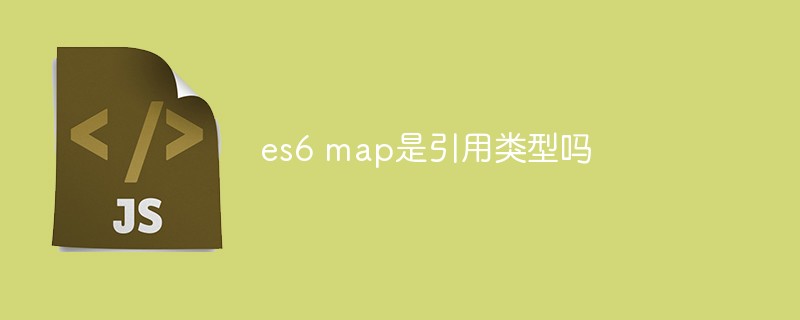
Map is a reference type; map (collection) is a new reference data type in es6, which represents the mapping relationship of data. Data in the map collection data type is stored in a "key/value" manner. You can use the properties of the object as the key and use the properties to reference the value; the map can be created using new, for example "const myMap = new Map();" .

The operating environment of this tutorial: Windows 7 system, ECMAScript version 6, Dell G3 computer.
map is a reference type.
Before ES6, to implement 'key'=>'value' in JavaScript, which is what we often call key-value pairs, is to use Object to complete. However, this implementation method has problems in special scenarios. ES6 has introduced a new collection type called Map, which brings a true key-value pair storage mechanism to the language.
map (collection) is a new reference data type in es6, which represents the mapping relationship of data; data in the map collection data type is stored in a "key/value" manner, and you can use the properties of the object As keys, use properties to reference values.
Use the new keyword to instantiate a map
let m = new Map();
console.log(m);
// Map(0) {}Initialization when creating:
Pass in a two-dimensional array parameter (an iterable object, the key value is passed in as an array internally)
For each sub-array, the first element corresponds to map key, the second element is the value
let m = new Map([[{}, 222], [{}, '123']]);
console.log(m);
// Map(2) { {} => 222, {} => '123' }let m = new Map();
m.set('prop', '值');
console.log(m);
// Map(1) { 'prop' => '值' }let m = new Map();
m.set('prop', '值').set('prop2', false).set('num', {id: 13});
console.log(m);
// Map(3) { 'prop' => '值', 'prop2' => false, 'num' => { id: 13 } } attribute to get the number of elements in the current collection<div class="code" style="position:relative; padding:0px; margin:0px;"><pre class="brush:js;toolbar:false;">let m = new Map();
m.set(&#39;prop&#39;, &#39;值&#39;).set(&#39;prop2&#39;, false).set(&#39;num&#39;, {id: 13});
console.log(m.size);</pre><div class="contentsignin">Copy after login</div></div>
let m = new Map();
m.set('prop', '值').set('prop2', false).set('num', {id: 13});
console.log(m.get('prop2'));
// falselet m = new Map();
m.set('prop', '值').set('prop2', false).set('num', {id: 13});
m.delete('prop2');
// true
console.log(m.get('prop2'), m.size);
// undefined 2let m = new Map();
m.set('prop', '值').set('prop2', false).set('num', {id: 13});
m.delete('prop2');
// true
console.log(m.has('prop2'), m.has('num'));
// false truelet m = new Map();
m.set('prop', '值').set('prop2', false).set('num', {id: 13});
m.clear();
// true
console.log(m);
// Map(0) {}##1-3 Sequence With iterationmap can iterate elements according to the order of insertion The mapping instance will provide (iterator). It can generate an array in the form of [key, value] in the order of insertion, and can pass entries () method (or provided Symbol.iterator) iterator interface traversal.
let m = new Map();
m.set('prop', '值').set('prop2', false).set('num', {id: 13});
console.log(m.entries === m[Symbol.iterator]);// true
for(let k1 of m.entries()){
console.log(k1);
// [ 'prop', '值' ]
// [ 'prop2', false ]
// [ 'num', { id: 13 } ]
// 遍历的属性即对应映射元素的键值对数组
}
for(let k2 of m.keys()){
console.log(k2);
// prop
// prop2
// num
// 遍历的属性对应映射元素的键
}
for(let k3 of m.values()){
console.log(k3);
// 值
// false
// { id: 13 }
// 遍历的属性对应映射元素的值
}
for(let k4 of m[Symbol.iterator]()){
console.log(k4);
// [ 'prop', '值' ]
// [ 'prop2', false ]
// [ 'num', { id: 13 } ]
// 遍历的属性即对应映射元素的键值对数组
}1-4 Comparison with ObjectMemory usage
Browser The difference will lead to different memory usage between the two storage methods. However, given the memory size, map stores about 50% more key-value pairs than Object.Insertion speed The performance of map and Object above are roughly the same, but if the code involves a large number of insertions, it is recommended to use mapInsert Performance
The difference is smaller Small, Object is better when it contains only a small number of key-value pairsFind speed
Object's delete() performance is poor, while map's delete() The performance is good. If the data involves a large number of deletion operations, it is recommended to use mapDelete performance
[Related recommendations:javascript video tutorial
The above is the detailed content of Is es6 map a reference type?. For more information, please follow other related articles on the PHP Chinese website!